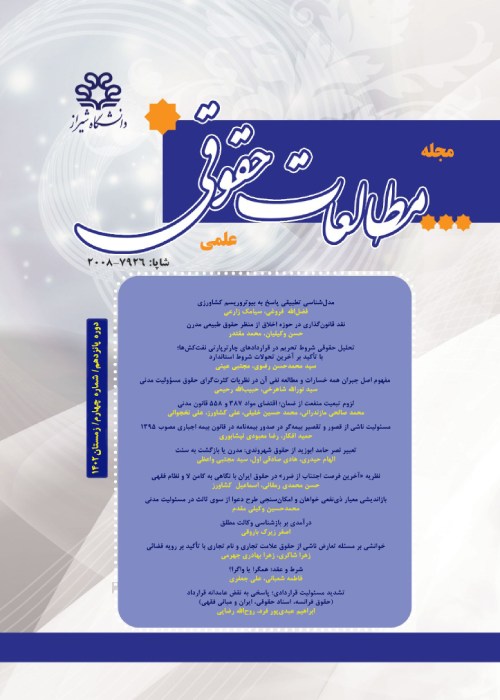Comparative Modeling of Responses to Agricultural Bioterrorism: A Legal Analysis
Author(s):
Article Type:
Research/Original Article (دارای رتبه معتبر)
Abstract:
The occurrence of any damage within the agricultural industry can have severe ramifications for national and food security. Addressing this insecurity necessitates international cooperation, foresight, and effective organization among countries. This article explores the potential of employing diplomatic strategies to establish response models for agricultural bioterrorism through bilateral or multilateral agreements and treaties. The central question addressed in this study is whether the Islamic Republic of Iran possesses a specific response model for addressing agricultural bioterrorism, akin to other nations. The examination reveals that Iran lacks a comprehensive risk management model within its criminal policy to prevent or mitigate agricultural bioterrorism and provide timely emergency responses. In contrast, countries like the United States, England, and Australia have recognized the significance of this threat for years, incorporating it into their national security frameworks. This descriptive study draws upon extensive document reviews, referencing numerous sources and articles. The dynamic global landscape, characterized by political, economic, and social transformations, underscores the critical importance of agriculture, which serves as a vital source of employment, self-sufficiency, and food security for nations. Consequently, one of the most economically impactful strategies that can be employed by malicious actors is targeting a country's agricultural and food supply. Terrorism, as a subject of criminal law and policy, encompasses various forms, with bioterrorism being particularly significant, as it encompasses a wide array of potential threats. An intentional biological attack on the agricultural sector can lead to extensive consequences, giving rise to the phenomenon known as agricultural bioterrorism or agroterrorism. Agricultural bioterrorism involves the deliberate release of pathogenic agents affecting animals or plants with the intent to instill fear, inflict economic damage, and disrupt a nation's stability. The discussion surrounding agricultural bioterrorism is multifaceted and fundamental, posing risks to agricultural products, livestock populations, and human health. Furthermore, it poses a threat to ecosystems and can facilitate the introduction of pests through contaminated seeds, infected livestock, novel fertilizers altering soil structure, tainted meat imports, and biodiversity concerns. In the context of threats to the agricultural industry, the emergence of "bio-agricultural warfare" or "bio-terrorism" as a contemporary phenomenon is not inconceivable.The threats associated with agricultural bioterrorism primarily stem from three factors: a lack of awareness among citizens and agriculture professionals, weak legal frameworks, and inadequate infrastructure to combat agricultural bioterrorism. In recent decades, these threats have undergone significant and complex developments on both domestic and international fronts due to factors such as the ease of transferring and storing biological agents, their ability to reproduce, the difficulty of attributing attacks to specific perpetrators, and the involvement of organized criminal groups. The economic and national security repercussions of an agricultural bioterrorism attack far surpass those of a conventional war, making it a pressing concern in the contemporary global landscape. The globalization of terrorism has allowed perpetrators to operate across international borders without restraint, making no region, government, or nation immune to their actions. Consequently, addressing the multifaceted challenges and threats posed by agricultural bioterrorism demands international cooperation among governments and international organizations.Models serve as valuable tools for navigating the complexity of the criminal process, similar to how natural science models offer coherent plans for experimentation. Within the criminal justice context, models simplify details while highlighting common themes and trends. A comprehensive criminal justice system can incorporate multiple models rather than adhering to a single, isolated model. In light of the interconnectedness of legal systems, it is imperative for contemporary legal systems to draw from the successes of others. Therefore, embracing various models and adopting an optimal criminal policy, in collaboration between government and social systems, offers a promising avenue for preventing and mitigating threats associated with agricultural bioterrorism, both domestically and internationally. This study underscores the importance of localized international regulations, swift and accurate methods for identifying dangerous biological agents, education initiatives, and the enactment of necessary legislation to address agricultural bioterrorism effectively.
Keywords:
Language:
Persian
Published:
Legal Studies, Volume:15 Issue: 4, 2024
Pages:
1 to 34
magiran.com/p2665382
دانلود و مطالعه متن این مقاله با یکی از روشهای زیر امکان پذیر است:
اشتراک شخصی
با عضویت و پرداخت آنلاین حق اشتراک یکساله به مبلغ 1,390,000ريال میتوانید 70 عنوان مطلب دانلود کنید!
اشتراک سازمانی
به کتابخانه دانشگاه یا محل کار خود پیشنهاد کنید تا اشتراک سازمانی این پایگاه را برای دسترسی نامحدود همه کاربران به متن مطالب تهیه نمایند!
توجه!
- حق عضویت دریافتی صرف حمایت از نشریات عضو و نگهداری، تکمیل و توسعه مگیران میشود.
- پرداخت حق اشتراک و دانلود مقالات اجازه بازنشر آن در سایر رسانههای چاپی و دیجیتال را به کاربر نمیدهد.
In order to view content subscription is required
Personal subscription
Subscribe magiran.com for 70 € euros via PayPal and download 70 articles during a year.
Organization subscription
Please contact us to subscribe your university or library for unlimited access!


